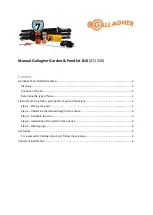
24 . Spotlight 150 User's Guide
A Guided Tour of the Spotlight 150
The Spotlight 150 enables you to collect IR spectra from extremely small samples. The
PerkinElmer cassegrain collection optics give high-performance infrared microspectroscopy.
The microscope includes a camera and viewing system that magnifies the visible-light image
of the sample so that you can see and position a point of interest. The image of your sample
is displayed on the Setup Microscope tab in Spectrum software. Spectrum enables you to
control the operation of your Spotlight 150, and collect IR spectra from the sample.
The microscope includes the following features:
•
A high-performance cassegrain mirror system; this has a wide collection angle (high
numerical aperture) and is highly efficient in collecting infrared radiation for
microspectroscopy.
•
Spectra can be collected in either reflectance or transmittance sampling modes.
•
Internal coaxial LED illumination, with variable intensity.
•
An automatic infrared aperture that closes to the size and rotation selected when you
select a scan or monitor command.
•
Spectrum software controls the operation of the microscope: for example, the
illumination of the sample, adjusting the correction, and changing to reflectance or
transmittance. Some versions of the microscope also feature LED lighting of the stage
area which is controlled from the software.
•
An optional micro-ATR objective for data collection from optically thick and non-
reflective samples. Manual and automatic ATR objectives are available.
•
Data collection (including saving the visible image) and post-run processing for IR
spectra.
•
The same cassegrain is used to send both infrared radiation and visible light to the
remote aperture. The microscope continuously views and monitors infrared
concurrently; there is no beam path switching between visible and infrared. Spectrum
software allows you to view the visible image and the IR spectrum simultaneously.
•
The lower cassegrain can be removed. This provides space for thick samples to be
studied in reflectance mode.
•
An InGaAs (indium gallium arsenide), a DTGS (deuterated triglycine sulfate), or an MCT
(mercury cadmium telluride) MIR detector is fitted.
Содержание Spotlight 150
Страница 1: ...Spotlight 150 User s Guide MOLECULAR SPECTROSCOPY ...
Страница 5: ...Introduction ...
Страница 11: ...Warnings and Safety Information ...
Страница 23: ...Overview of the Spotlight 150 ...
Страница 32: ...32 Spotlight 150 User s Guide ...
Страница 33: ...Getting Ready to Use the Spotlight 150 ...
Страница 45: ...Preparing Samples ...
Страница 58: ...58 Spotlight 150 User s Guide ...
Страница 59: ...Techniques for Collecting Spectra ...
Страница 94: ...Maintenance ...
Страница 102: ...Appendices ...















































